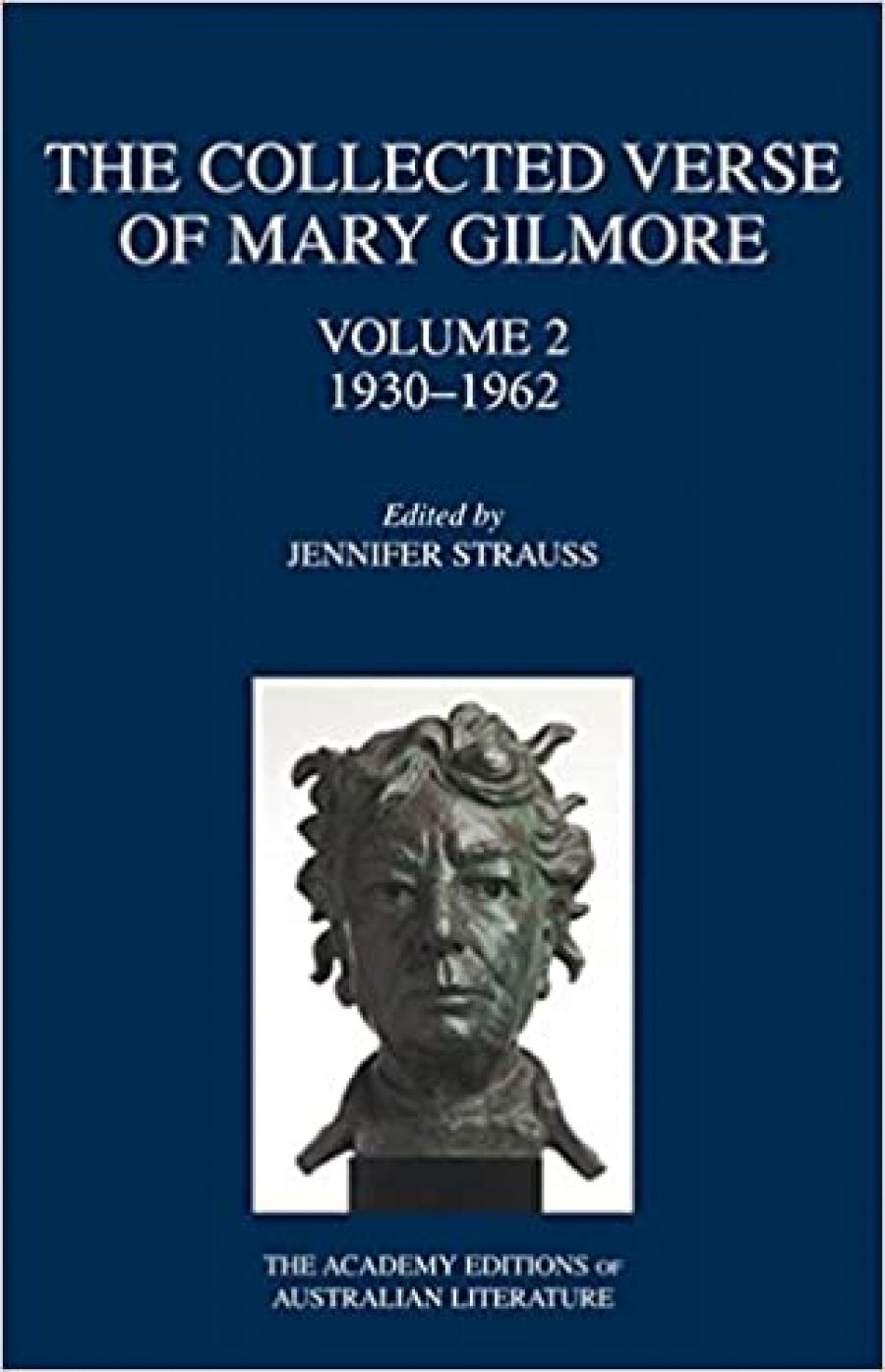
- Free Article: No
- Contents Category: Poetry
- Review Article: Yes
- Online Only: No
- Custom Highlight Text:
As the size of Jennifer Strauss’s two-volume scholarly edition of Mary Gilmore’s verse attests, Gilmore (1864–1962) is one of the most prolific poets in Australian literature. At around 800 pages, Volume 2 complements the first volume (which Vivian Smith reviewed in ABR, February 2006). Together, these two volumes represent the most detailed editing of an Australian poet to date. Rayner Hoff’s bronze statue of Gilmore’s head on the cover signals the consolidation of Gilmore’s reputation in the last thirty years of her life. (In 1933 Gilmore became a life member of the Fellowship of Australian Writers; five years later, she was made Dame of the British Empire.)
- Book 1 Title: The Collected Verse of Mary Gilmore
- Book 1 Subtitle: Volume 2, 1930–1962
- Book 1 Biblio: University of Queensland Press, $80 pb, 872 pp
Gilmore often represented herself as a champion of the poor, the disinherited and the marginal; she also identified as being part of this clan of ‘small’ folk. In ‘When I am Gone,’ one of her last poems, she declared:
When I am gone I ask
No mighty ones to follow me;
No lions, tigers, elephants or tall giraffes
But just the little ants –
The little folk
Who, day and night,
Carry the burden of the small
And save the world –
These were my friends in life;
In death they will remember me.
Despite this putative meekness, Gilmore was keen to record her literary achievements; at times she exaggerated or imagined personal details. In her later life, she reflected not only on the broad canvas of Australia’s history but upon her own, sprinkling her letters to Nettie Palmer or Zora Cross with personalia in a thinly veiled attempt to interest them in writing her biography.
The new volume demonstrates how Gilmore began concentrating on collected publications rather than being content to leave poems scattered across newspapers and journals. Accordingly, the sections of uncollected verse are slim and infrequent. Volume 2 opens with the lengthy collection The Wild Swan (1930), which, as Strauss notes, reveals Gilmore’s poetic powers at their consistent best. Its title poem draws intertextual parallels with W.B. Yeats’s The Wild Swans at Coole (1919), pointing to an affinity between the dispossession and dispersal of Aboriginal and Celtic cultures. In this collection, Gilmore positions Aboriginal culture as an important historical thread to present-day national identity. Distancing herself from what she frames as a particularly masculine history of colonial oppression and war, she offers instead a maternalism that enables her both to empathise with and to oversee her subjects. While she stresses a commonality of gender in well-known poems such as ‘The Lament of the Lubra’ and ‘The Woman of Five Fields,’ Gilmore is also able imaginatively to evoke the young soldier. Against the poems on Aboriginal culture and the Anzacs were a number of fine poems on natural phenomena, including Australian bird life. Gilmore contended that women’s innate empathy gave them a greater capacity to engage with and represent the natural and cultural worlds.
The Wild Swan would be quickly followed by The Rue Tree (1931) and Under the Wilgas (1932), the former suggesting how God is often witnessed or engaged with through the natural world, while the latter volume extended Gilmore’s exploration of Aboriginal culture. Although largely self-funded, the three collections of the early 1930s would reaffirm the success she had achieved with The Passionate Heart (1918). Strauss notes that she decided to finish the first Academy Editions volume with the poems of The Titled Cart (1925) and some of the uncollected poems that followed, since they concluded Gilmore’s ‘role as a Bulletin-style versifier of bush themes and bush ballads’. Yet the love of the pioneering spirit (with its stoicism and work ethic) that Gilmore displays in her early poetry is found in a more mature light in her later writing. It is exemplified in her famous poem ‘Never Admit the Pain’, where ‘Silence is still a crown, / Courage a grace’, and also in her popular prose collections, Old Days: Old Ways (1934) and More Recollections (1935). Indeed, Gilmore’s work from the 1930s onwards extends many of the themes found in her earliest verse. There are more translations from the Spanish, further identification with the rebellious, the working class and the socially displaced. The poems are particularly memorable when describing gendered social injustice. As with Gilmore’s early verse, the later writing occasionally veers toward the sentimental for sentiment’s sake, such as the many poems touching on the death of a mother during childbirth or the shortness of a child’s life.
The second volume contains Battlefields (1939), The Disinherited (1941), and Fourteen Men (1954). These volumes would continue Gilmore’s engagement with Aboriginal culture, ‘The Wild Plum’ arguing for a pure, primeval Aboriginal culture, unsullied by miscegenation or assimilation, and espousing its freedom of spirit in ‘An Aboriginal Simile’. Strauss’s meticulous editorial notes demonstrate Gilmore’s debt here to sources of Aboriginal narratives and lore, such as Keith McKeown and William E. Harney.
Gilmore went on writing for most of her ninety-seven years. Given the poet’s combined longevity and productivity, Jennifer Strauss’s two volumes in the Academy Editions offer an invaluable resource not only for scholars and students of Mary Gilmore’s poetry but for those seeking a better sense of the thematic and formal development of Australian literature more broadly.


Comments powered by CComment